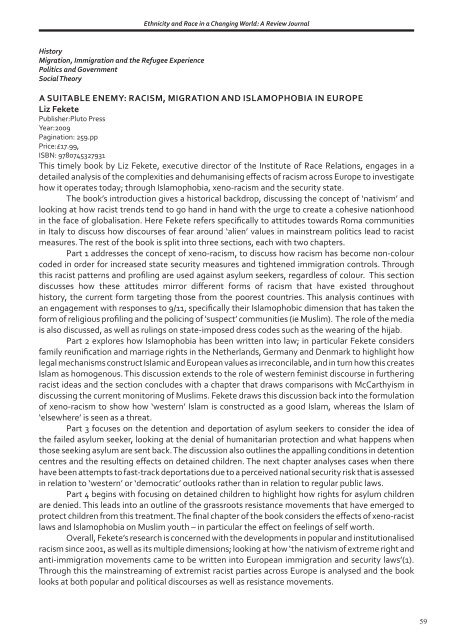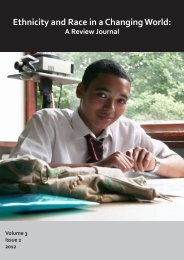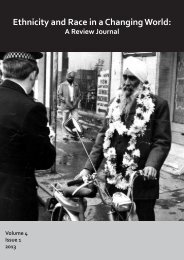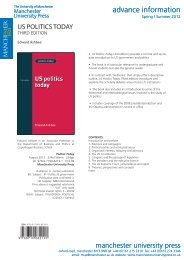Ethnicity and Race in a Changing World
Volume 2, Issue 1, 2010 - Manchester University Press
Volume 2, Issue 1, 2010 - Manchester University Press
- No tags were found...
You also want an ePaper? Increase the reach of your titles
YUMPU automatically turns print PDFs into web optimized ePapers that Google loves.
<strong>Ethnicity</strong> <strong>and</strong> <strong>Race</strong> <strong>in</strong> a Chang<strong>in</strong>g <strong>World</strong>: A Review JournalHistoryMigration, Immigration <strong>and</strong> the Refugee ExperiencePolitics <strong>and</strong> GovernmentSocial TheoryA SUITABLE ENEMY: RACISM, MIGRATION AND ISLAMOPHOBIA IN EUROPELiz FeketePublisher:Pluto PressYear:2009Pag<strong>in</strong>ation: 259.ppPrice:£17.99,ISBN: 9780745327931This timely book by Liz Fekete, executive director of the Institute of <strong>Race</strong> Relations, engages <strong>in</strong> adetailed analysis of the complexities <strong>and</strong> dehumanis<strong>in</strong>g effects of racism across Europe to <strong>in</strong>vestigatehow it operates today; through Islamophobia, xeno-racism <strong>and</strong> the security state.The book’s <strong>in</strong>troduction gives a historical backdrop, discuss<strong>in</strong>g the concept of ‘nativism’ <strong>and</strong>look<strong>in</strong>g at how racist trends tend to go h<strong>and</strong> <strong>in</strong> h<strong>and</strong> with the urge to create a cohesive nationhood<strong>in</strong> the face of globalisation. Here Fekete refers specifically to attitudes towards Roma communities<strong>in</strong> Italy to discuss how discourses of fear around ‘alien’ values <strong>in</strong> ma<strong>in</strong>stream politics lead to racistmeasures. The rest of the book is split <strong>in</strong>to three sections, each with two chapters.Part 1 addresses the concept of xeno-racism, to discuss how racism has become non-colourcoded <strong>in</strong> order for <strong>in</strong>creased state security measures <strong>and</strong> tightened immigration controls. Throughthis racist patterns <strong>and</strong> profil<strong>in</strong>g are used aga<strong>in</strong>st asylum seekers, regardless of colour. This sectiondiscusses how these attitudes mirror different forms of racism that have existed throughouthistory, the current form target<strong>in</strong>g those from the poorest countries. This analysis cont<strong>in</strong>ues withan engagement with responses to 9/11, specifically their Islamophobic dimension that has taken theform of religious profil<strong>in</strong>g <strong>and</strong> the polic<strong>in</strong>g of ‘suspect’ communities (ie Muslim). The role of the mediais also discussed, as well as rul<strong>in</strong>gs on state-imposed dress codes such as the wear<strong>in</strong>g of the hijab.Part 2 explores how Islamophobia has been written <strong>in</strong>to law; <strong>in</strong> particular Fekete considersfamily reunification <strong>and</strong> marriage rights <strong>in</strong> the Netherl<strong>and</strong>s, Germany <strong>and</strong> Denmark to highlight howlegal mechanisms construct Islamic <strong>and</strong> European values as irreconcilable, <strong>and</strong> <strong>in</strong> turn how this createsIslam as homogenous. This discussion extends to the role of western fem<strong>in</strong>ist discourse <strong>in</strong> further<strong>in</strong>gracist ideas <strong>and</strong> the section concludes with a chapter that draws comparisons with McCarthyism <strong>in</strong>discuss<strong>in</strong>g the current monitor<strong>in</strong>g of Muslims. Fekete draws this discussion back <strong>in</strong>to the formulationof xeno-racism to show how ‘western’ Islam is constructed as a good Islam, whereas the Islam of‘elsewhere’ is seen as a threat.Part 3 focuses on the detention <strong>and</strong> deportation of asylum seekers to consider the idea ofthe failed asylum seeker, look<strong>in</strong>g at the denial of humanitarian protection <strong>and</strong> what happens whenthose seek<strong>in</strong>g asylum are sent back. The discussion also outl<strong>in</strong>es the appall<strong>in</strong>g conditions <strong>in</strong> detentioncentres <strong>and</strong> the result<strong>in</strong>g effects on deta<strong>in</strong>ed children. The next chapter analyses cases when therehave been attempts to fast-track deportations due to a perceived national security risk that is assessed<strong>in</strong> relation to ‘western’ or ‘democratic’ outlooks rather than <strong>in</strong> relation to regular public laws.Part 4 beg<strong>in</strong>s with focus<strong>in</strong>g on deta<strong>in</strong>ed children to highlight how rights for asylum childrenare denied. This leads <strong>in</strong>to an outl<strong>in</strong>e of the grassroots resistance movements that have emerged toprotect children from this treatment. The f<strong>in</strong>al chapter of the book considers the effects of xeno-racistlaws <strong>and</strong> Islamophobia on Muslim youth – <strong>in</strong> particular the effect on feel<strong>in</strong>gs of self worth.Overall, Fekete’s research is concerned with the developments <strong>in</strong> popular <strong>and</strong> <strong>in</strong>stitutionalisedracism s<strong>in</strong>ce 2001, as well as its multiple dimensions; look<strong>in</strong>g at how ‘the nativism of extreme right <strong>and</strong>anti-immigration movements came to be written <strong>in</strong>to European immigration <strong>and</strong> security laws’(1).Through this the ma<strong>in</strong>stream<strong>in</strong>g of extremist racist parties across Europe is analysed <strong>and</strong> the booklooks at both popular <strong>and</strong> political discourses as well as resistance movements.59






